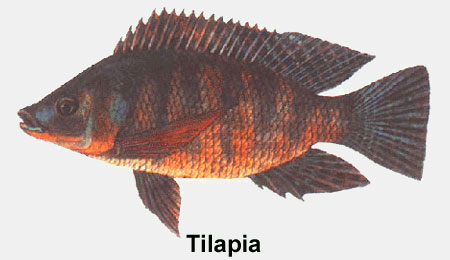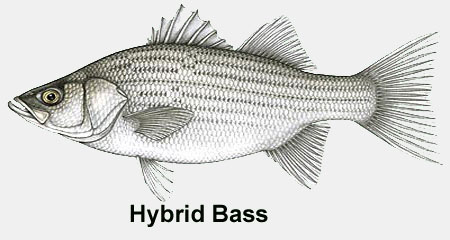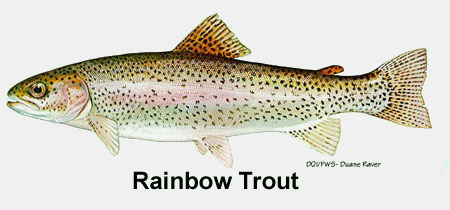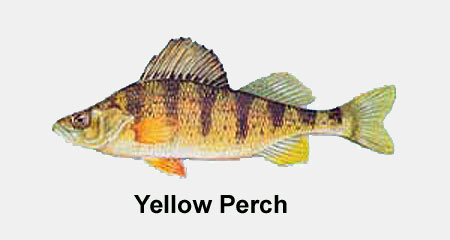



 |
 |
 |
 |
While theoretically any aquatic organism can be raised in a recirculation system, in practice, recirculation aquaculture is dominated by just a few. Species that prosper in recirculation systems include various species of the tropical cichlid collectively known as tilapia, the hybrid cross of striped bass and white bass usually referred to as hybrid bass, rainbow trout, and yellow perch.
 |
This fish, native to equatorial Africa, is particularly suited to recirculation systems for several reasons. They are very hardy (we've actually discovered them on floor beneath their tanks with drying fins and had them swim away when returned to the water!). They can be crowded at high densities and rarely have disease outbreaks. They are very fecund mouth brooders. The females lay eggs on a substrate and the male fertilizes them and protects the eggs and sac fry in his mouth until they are free swimming. Their fecundity often leads to overpopulation in ponds, but the densities in recirculation units usually precludes unwanted reproduction.
Since temperatures less than about 10o C (50o F) are lethal, pond culture of tilapia in temperate climates is restricted to warm weather months, thus making indoor recirculation systems mandatory for at least part of the year. Though "different" to North American consumers, tilapia have gained popularity and are now widely available in supermarkets and restaurants across the U.S. These fish are either imported from pond culture in tropical countries or are grown in recirculation units.
Striped bass are a marine fish that are very popular table fare in the northeastern U.S. In recent years, wild stocks have fluctuated greatly and often and traditional ocean fisheries for this species have not been able to reliably meet the demand. The hybrid with the striped bass's freshwater cousin, the white bass, tolerate freshwater and a broader temperature range than the oceanic fish. They also tolerate crowding within recirculation systems and bring a higher price than tilapia, making them a popular fish for recirculation aquaculturists.
A potential limiting factor with hybrid bass is fry supply. Currently most hybrid bass fry are produced by artificially crossing the parent stock and the parent stock must be obtained from the wild. This potentially limits the supply and increases the cost.
Rainbow trout are arguably the only truly domesticated fish having been raised continually in hatcheries for over 50 generations and they were one of the first species to be tried in recirculation aquaculture. Rainbow trout are fairly hardy and tolerate crowded conditions, so they perform reasonably well in recirculation units. They are, however, cold water fishes and will not grow well when temperatures exceed about 18o C (65o F), so they are limited to fairly cool areas (e.g. upstate New York) where average daily indoor temperatures rarely exceed this in the summer. Otherwise, refrigeration expenses would make recirculation production of trout prohibitive. Also, they require more oxygen and tolerate less ammonia than other recirculation species which can be difficult to achieve.
In the midwest, the yellow perch is a very popular panfish and it is being raised in recirculation systems for both food and for restocking wild populations. While they do well after they reach about 8 cm (3 inches) and are not particularly difficult to breed, the fry are difficult to feed on artificial feed and fry losses can exceed 30%.
While commercial recirculation aquaculture focuses on these "big four", many other species of aquatic organisms have been raised successfully. This includes marine finfish and aquatic invertebrates such as lobsters and freshwater and marine shrimp. It is possible that these higher value species may become economically feasible in recirculation systems in the future.